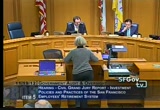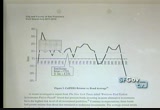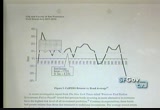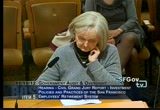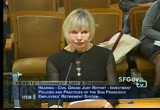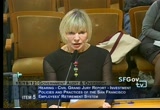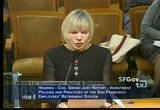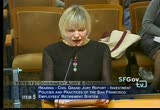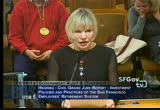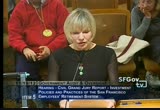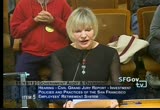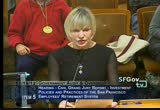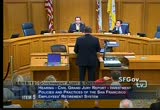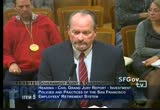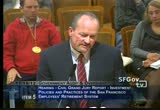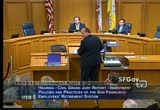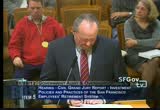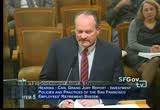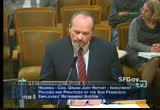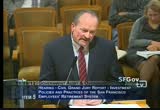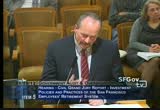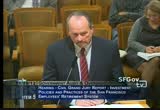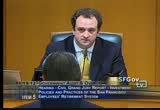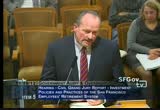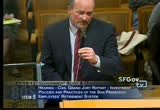tv [untitled] November 29, 2012 5:30am-6:00am PST
5:30 am
>> it's on your report also. i'm not sure what page. figure 3 in your reportws&jjñ. >> supervisor elsbernd: we have it. it's on page 9. what might be helpful for folks at home if is you had a copy if you would put it on the projector as opposed to that, if you want members of the public to see that. i was saying a copy of the civil grand jury report that you can stick on the projector. our clerk will do it. go ahead. >> what the stanford institute compared was the cal-pers return to hypothetical low risk portfolio pursued over the same 25 year time period, a negligible -- the "new york times", in 2012 found that pension funds investing in more alternative investments, not
5:31 am
only have the highest risk levels, but contrary to expectations had poor returns than those that remained in traditional low risk investments. they further found that funds that did well with low risk investment policies nevertheless tended to switch to high risk model. and the reason for that is the upjohn institute in 2011 report titled an analysis of risk-taking behavior for public pension plans of over 100 funds found pressure on fund managers to change from their conservative investment policy to assume more risk, even if a fund made a higher return with a low risk portfolio. economists referred to this trend as the herd mentality. the jury can verify to the board of supervisors that studies do exist are easily found in our --
5:32 am
fromibt#n0v respected institutis showing that public pension funds with low risk investment policies perform as well as better than those with high risk policies as stated in our findings on page 7. we do not understand why the pension board, or its executive director, can't confirm or deny these reports exist. the jury recommends that a fund to see if we couldn't go back to investing in a low risk -- we're in a position of trust. finally, i would like to repeat a warning in the 1984 research report by the institute of industrial relations university of california-berkeley about the passage of hot prop 21. prop 21 may threaten the -- of
5:33 am
employees in california than it offers to protect them. proposition 21 will be successful only if it sends a message to all public employees in california. the message is not only that they need to exercise constant vigilance to protect their entitled to much more information than they are now getting on how their pension fund savings are invested. and how their pension plans are funded. thank you. >> supervisor elsbernd: thank you. >> thanks, jean. i wanted to answer some of the jury's findings and answer, prior to the pension board's presentation, some of
5:34 am
their responses to our findings. first of all, finding no. 1, the pension board does appear to agree with the jury's finding that the underfunding is over $2 billion, and just to remind you the jury notes that the actual underfunding is $3 billion, but it is reduced by the fund's estimate of its 7.66% future investment returns. finding no. 2, the jury said that the retirement board did not complete a failure analysis downturn. the pension board and staff responded that the losses were the result of unprecedented conditions in the financial market. they say that the board did conduct an analysis because they asked their advisers to make a
5:36 am
downturn. by the board's own description, it merely asked its paid consultants to explain the failures. the funds answer that they are not responsible for the losses because most other public funds followed the same high risk investment policies and also lost money is not acceptable. the pension fund should not be managed with a herd mentality. policies and practices should follow the facts and not imitate what others are doing. retirement funds that were invested mostly in bonds did not suffer such catastrophic losses and they protected their assets. some would say that they were prudent. it did not happen to everybody. only to the majority, who were pursuing higher and higher returns in a bubble market. a failure analysis should have been conducted, and is also
5:37 am
warranted at the present time, to preserve the safety of the fund from catastrophic losses. the 2008-09 disaster was man-made, but even in a natural disaster such as an earthquake or a flood, public agencies conduct thorough in-depth investigations to discover why some structures were steroid and why others -- destroyed and some survived. consultants say we followed the consultant and regularly review our risk and allocations. our answer is neither the fund's investment consultants, its staff, nor its bank, warned the the board about a possible loss in 2008 on09. nevertheless, the fund did not question their comp hennessy, and to this day retains the same advisers, bank and staff.
5:38 am
following the earthquake analogy, it is inadvisable to consult only the same engineers, architects and builders who designed and structured a structure that was destroyed in order to determine what went wrong or correct for the future it's important to consult with independent third party who are not just interested in maintaining the business relationship. regarding the risk analysis we were told by board members who served in 2009 that there were no substantive changes after the 2009 losses. the jury has reviewed the reports of risk and allocations. in those reports, risk is not addressed in terms of the safety of the principal. instead, risk is addressed as the degree of risk that needs to be taken in order to attain a
5:39 am
it is also addressed in terms of hedging, on the assumption that you can entirely eliminate the downside of volatility by allocating in investments that usually go up when the economy is down. finding three, we're just on finding three, almost there -- the jury said -- >> supervisor elsbernd: can i suggest, finding three, city must pay increasing contributions to the fund due to underfunding. i don't think anybody disagrees with that. >> i would rather not be rushed through this, if you don't mind. i'm sorry. we've waited all day and i'd rather not be rushed. >> supervisor elsbernd: is there anyone who disagrees with that fact? >> i would like rather not to be rushed. thank you. >> supervisor elsbernd: i just have to state this. i need to be at land use committee. >> can we -- i'd be happy to postpone, if you don't mind. >> supervisor elsbernd: that's not going on work.
5:40 am
>> we're talking about 15 billion at stake. and i would rather not have it be rushed. >> supervisor elsbernd: and i agree but i have a lot of about on the points of disagreement. >> good. >> supervisor elsbernd: i don't want to waste time on points we all agree on. >> i think that it was said, in the pension fund response, that after 2015 the payments may decrease. this was a statement they made and we have an answer to that statement. did you want to look through and see that? because we disagree with that. >> supervisor elsbernd: president chiu and i are going to be voting on this resolution. he and i agree with that finding with that finding. you can move on to finding 4 which is also a finding that i think we agree with. >> i have to say i was concerned when you were the president of this hearing, or the chairman of this hearing because i know you
5:41 am
are one of the people that we investigated. you were part of the board. and i was hoping you would be very impartial to this. >> supervisor elsbernd: i'm agreeing with your finding, ma'am. >> i understand that. finding 4, the jury says that the increases in pension contributions by the city are growing at a faster rate than expenditures on most city services since 1999. the fund says that they neither confirm nor deny this. the jury answer is that the controller agreed with this finding. the jury believeses that since the city insures the fund against investment losses they should play an active part in influencing the investment risk. it's common for an insured to limit and penalize risk and even to refuse to deal with matured individuals who do not exercise
5:42 am
sufficient care over their health or property nevertheless we think the board and staff should show awareness of impact of investment losses on the health of the city budget. recommendation 1 -- almost done, recommends that a high level task force meet and discuss these issues. the board says that this is not warranted because proposition c took care of all the problems. the jury answer is that the board's actuary took into account the impact of proposition c when the future city contribution was calculated. proposition c has to do with benefit reform and not with the fund's investment policies. the board says that as fiduciaries we should not consult others on decisions. our answer is that we are astonished and disappointed by
5:43 am
this statement. in essence it is refusal by the board to be accountable to those whose money it is to the conduct of its investment program. as fiduciaries the board should parties. the board should conduct comparisons of investment strategies and consult with independent third party experts. the board should be transparent, making sure that all these parties are informed of the facts, the history and implications of decisions. the board is already delegating its authority by abdicating leadership power and responsibility to outside hired consultants. it doesn't make sense that the pension fund believes it is okay to follow the advice of its paid investment consultants but it is not okay to read reports or consult with third party experts in the field. we found that the board and
5:44 am
staff of the fund are comprising the safety of the fund by prioritizing investment returns over principle. they're ignoring this current and future impact of their past and current risk-taking on the city budget. they're refusing to read or acknowledge, let alone consider and discuss low risk investment policies which could meet the primary objective of preserving capital and also aachieve nearing the same arenas over time. the jury did not recommend the board eliminate the legitimate goal of seeking return on investments. the jury believes that the elected representatives of this city should insist the board follows principles of prudence make preserving capital a first priority. thank you.
5:45 am
>> supervisor elsbernd: nins else from the grand jury? great. jay, you want to come forward? is. >> good afternoon, supervisors, jay -- executive director of the san francisco employees retirement system. i have some very brief prepared remarks that i would like to go through. on behalf of the retirement board we thank the civil grand jury for their service, however that being said, we are very disappointed that their report ignores long-standing policies and public decision-making practices of the retirement board and staff. these have been in place for decades. most of the recommendations from the civil grand jury have been implemented, as we've indicated in our response, and as part of its regular annual process the retirement board, its investment and actuarially consultants, staff, conduct ongoing comp comprehensive review and analysis of both the trust investment performance as well as the funding status of the
5:46 am
plan. i can go through onuepf÷ the investment side the process, but long-standing process. staff obviously is monitoring the performance of the plan on a daily basis. the chief investment officer reports to the board on a monthly basis the status of the plan. there are quarterly reports prepared by our custodial bank ond our investment consultant that are going to at a public meeting presented and discussed. those quarterly reports were done before, throughout, and after the financial markets or the downturn that we saw in 2008-09. also every three years, the board engages and the investment consultant engages in an activity very similar to what they're describing of these studies, an asset liability modeling project, where they go through and consider alternative composition of the portfolio and they're measured and it's
5:47 am
reported on a every three year basis. the last one was done in 2011. i assume the civil grand jury had access to that report. the details of that report again were presented in a public meeting with public discussion. everyone was welcome to attend and provide their input. on the actuarially side -- >> supervisor elsbernd: could you also talk -- our watch list, what our investment advisers are telling us, we get down to the granular detail of these investments. can you talk about that too. >> sure. quarterly reports are at a quarterly level against benchmarks approved by the retirement boards. they're at a total trust level and down to a manager level. any manager for either personnel issues or performance issues that don't meet benchmarks are put on watch lists. they are discussed -- they're considered at least no less than every quarter. it in perspective we're talking about a $15 million fund, these are managers that manage how
5:48 am
much of our money? they could have accounts asvi as -- >> a couple hundred million. >> supervisor elsbernd: and going down to that kind of detail. >> absolutely. on the actuarially side the practice is well established in the industry. there is requirement that there be a valuation done annually. part of that valuation is the consulting actuary firm that is hired by the retirement system brings forward their analysis on the economics of the current situation, in preparation for preparing the economic evaluation. not just the investment return but also the wage assumptions and cpi assumptions are considered and discussed and approved by the retirement board. part of their report indicates that it's the investment consultant that brings forth the recommendation for the investment return assumption. that is not correct. it's the actuarially consulting firm that brings forth recommendation for the assumed
5:49 am
investment return, as they do for all of the assumptions that will be used in the actual evaluation. >> supervisor elsbernd: so to be very specific, tie ron is the actuary who puts forward the return. how many of our investments do they advise us on? none. nothing to do with our investments, purely on the actuarially side of it. >> absolutely. >> supervisor elsbernd: okay. >> hold on, jay. if you're going to keep waving at me -- >> if i could comment. >> supervisor elsbernd: go ahead. >> as i indicated each year that the valuation is performed it's a snapshot of a given time. our plan year is june 30. it could very well be the end of a calendar year but in our case it's always june 30. typically what it will be is the measurement will be on the investment performance as of a given year. however the retirement board has
5:50 am
adopted a five year smoothing policy which basically says that in order to avoid abrupt changes to employer contributions, typical in the industry, some plans have adopted them for even longer durations, we only recognize losses and gains over a five year period. so if -- that there wouldn't be dramatic or disruptive types of fluctuationses in the employer contribution rate. all of these long-standing investment actuarially policies more than satisfy the majority of the recommendation recommendd to the board's consideration of the long-term investment assumption, the comprehensive and ongoing analysis of its investment policy and performance risk management and actuarially funding. each year the plan's performance returns, the actual experience analyses and evaluations are reported extensively through a public process at which all are welcome to participate.
5:51 am
the civil grand jury report focuseses on the difficult financial markets in 2008-09 and resulting loss in value in the sf -- trust and corresponding increase in unfunded actuarially liabilities. i will point out we realized no losses. these were unrealized losses los a result of the downturn in the markets. challenges associated with the 2008-09 are well known and have been the focus of both the mayor, the board of supervisors, plan beneficiaries, and electorate over the past three years. let's look at what the city and retirement board have done since 2009. first, stakeholder groups were brought together in 2010 and pension reform propositions that address the increasing lients of the plan and will save the city
5:52 am
significantly in the future. the collaboration of stakeholder led by the board of supervisors and the mayor's office in 2010 and 11 included extensive public discussion of numerous approaches to closing the sf -- funding gap. second, in december 2011, the retirement board approved the actuarially's recommendation to phase in a decrease of the plan's long-term investment return assumption from 7 3/4 to 7 1/2 over two years. from 2011 to 2013, next year, july 1, 2013, the return assumption will ben=j3p 7 1/2%. the decision of the retirement board keeps sf -- ahead of the curve. pension investment newspaper and industry recognized industry newspaper recently reported that among the top 100 pension funds in the united states the average
5:53 am
actuarially assumed rate of return for 2011 was 7.84%. ours was 7.66%. millman also brought out a report and published itzcd= in pension investments saying that for -- in october, that for 2011, the mean contribution or assumed return rate for the top 100 was 8%. we were well below that. third, let's look at what's happened with the investment practice of the retirement board since twoan 20. the trust has returned on an annualized basis 11.17% in each of the three years. the unrealized loss in market value was not a failure of the board's investment policy or their practices.
5:54 am
but rather a result of extraordinarily difficult financial markets. the great depression was mentioned. we paid benefits through the great depression. we paid benefits through theút( 2008-09 financial markets. the rier retirement board focusn very long term. over 20 years periods -- the 20 year period through june of this year, our return was 8.17%. our -- the retirement board's actions during that same 20 year period show that,x %( 6w at one, they increased the assumed rate up toua decreasing it to recognize that in fact their consulting and that the board understand how to prudently manage thed2( w< syst.
5:55 am
we never said, in our responses, that we would not take or consider other people's ideas or approaches. and i'm sad to hear that she's representing that that was part of our response. what we've said is, xja*v the california constitution, and the charter of san francisco, the retirement board has plenary authority to make these decisions, that they can't delegate that to a task force or to a group or to anyone else, but as far as the public nature of all of these discussions surrounding both what happened, what failed, what succeeded, they're all done in a public arena, everyone is invited to participate. the decisions that they make on the actuarial assumptions are made in a public arena, and that over the decades, i think the bottom line is the retirement board has shown, through very difficult -- sometimes difficult
5:56 am
financial markets, that they are singularly dedicated to preserving and prudently investing the trust assets, paying the benefits, and administering the mandated benefit programs. you ask me, just sort of comment, on what the employer contribution rate looked like over the years. i don't have the chart in front of me but there were times when the employer contribution rate exceeded 100% of pay. was in the 60 to 70%. aside i raised that point because those were years when we do not do alternative investments so the notion that is some sort of panacea to fix the city contribution is just bunk. >> also the report indicates that from 2004 to 2007 there were no contributions made to the plan. in fact, from 1998 through 2004, because of the funded nature of
5:57 am
the plan, there were no required employer contributions, however employee contributions were made. either by the employees themselves or on behalf of the employees in every year of the existence of this plan. so to characterize that there was ays( 0% period of time whee were no employee contributions made is a misrepresentation. >> supervisor elsbernd: and while we cannot go back add correct the past that will never happen in the future as a result of proposition c. >> right. you were one of the primary authors of proposition c. i mean there's an underlying roughly 10% to 11% obligation of an employer to properly fund the pension. and you, through proposition c, actually provided that in the event -- and the event could very well happen, where the employer contributions required from the plan went lower than that 10 or 11% level, that that money was again sent over to the
5:58 am
retiree health trust in order to retire the obligation for retiree health. be happy to answer any other questions. like i said, i was focusing on the recommendations, and i think that our policies and our practices that we can clearly public meetings, more than satisfy the recommendations or the intent of the recommendations as we read them and the mayor's office and the controller's office have also supported the retirement system and the board's position on -- in responding to these. >> supervisor elsbernd: fair enough. thank you, jay. you wanted to respond? if you can come to the mic. >> thanks very much. i just have a couple of very small requests. one of them is that we did put forth three studies that only take -- would take someone like
5:59 am
jay huish or his staff an hour to compare the results of the san francisco system, and put those into those studies. one of them is the cal-pers study that i have before me, and i think he kind of verbally did that. it doesn't take a lot to do that. it won't take tons of staff time, and i hope that you would do that. >> first of all we're very familiar with joe nation who basically is the one who -- >> supervisor elsbernd: yes. >> as an advocate for pension reform, compiles these types of comparison studies. what i was trying to imply and actually stated, every three years the board goes through this exact process. they use actual positions in the current portfolio and they go forward and model those to try and find out
86 Views
IN COLLECTIONS
SFGTV: San Francisco Government Television Television Archive
Television Archive  Television Archive News Search Service
Television Archive News Search Service 
Uploaded by TV Archive on

 Live Music Archive
Live Music Archive Librivox Free Audio
Librivox Free Audio Metropolitan Museum
Metropolitan Museum Cleveland Museum of Art
Cleveland Museum of Art Internet Arcade
Internet Arcade Console Living Room
Console Living Room Books to Borrow
Books to Borrow Open Library
Open Library TV News
TV News Understanding 9/11
Understanding 9/11